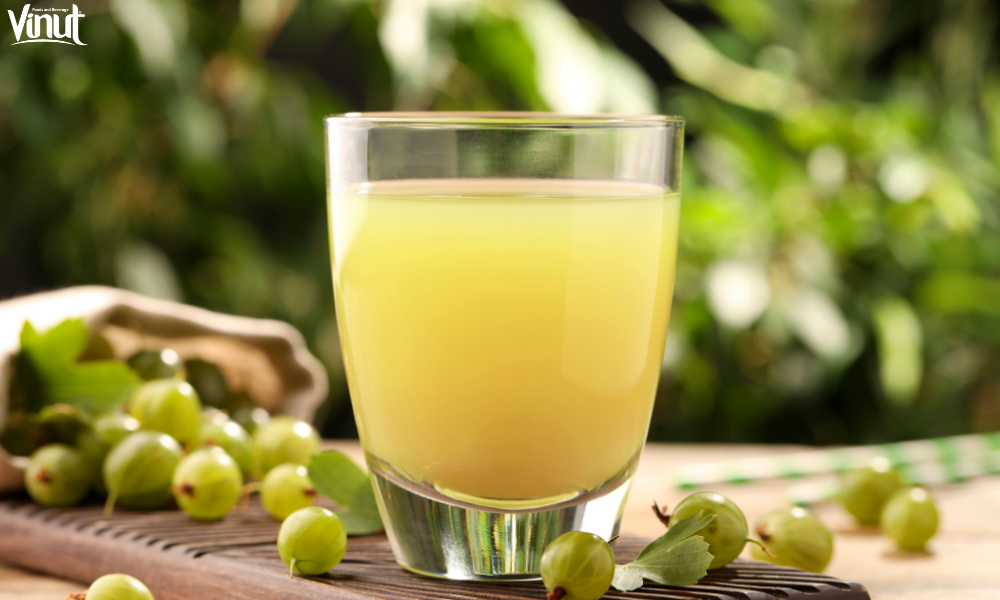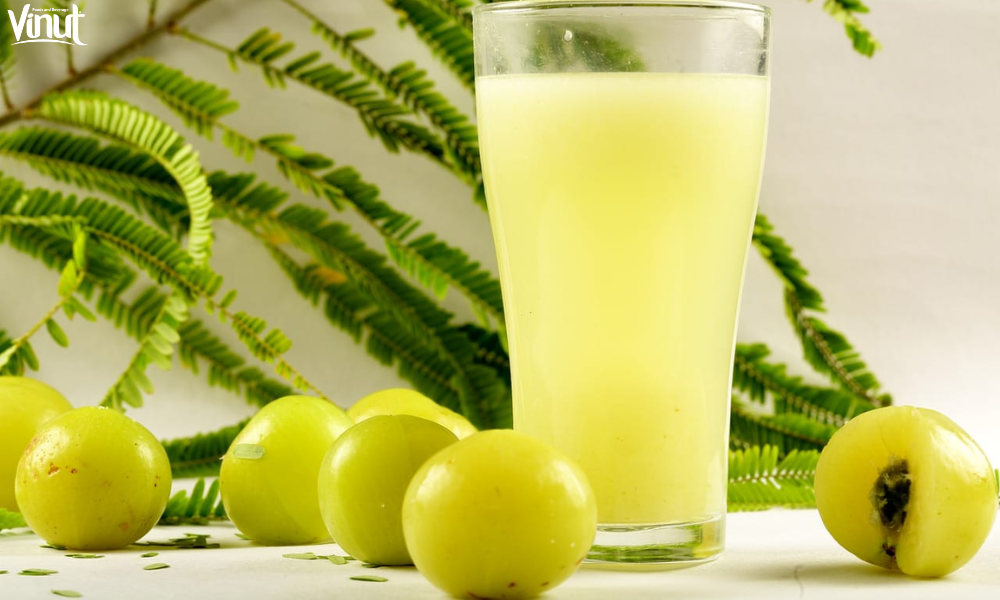Amla, also known as Indian gooseberry, is a popular fruit native to Asia. It has been used for centuries in traditional Ayurvedic medicine for its various health benefits. Recently, amla juice has gained popularity as a convenient way to consume this nutrient-dense fruit.
In this blog post, VINUT will explore the benefits of amla juice and how it can positively impact your health.
How to Make Amla Juice at Home
Before diving into the benefits of this juice, let’s first learn how to make it at home. Making fresh juice is simple and can be done with just a few ingredients. Here’s a quick recipe to get you started:

Ingredients:
- 1 cup fresh amla (Indian gooseberries)
- ½ cup water
- Honey or sugar (optional)
Steps:
- Wash the amla thoroughly and remove any seeds.
- Cut the amla into small pieces and put them in a blender.
- Add ½ cup of water and blend until smooth.
- If desired, add honey or sugar to taste.
- Strain the juice through a fine mesh sieve.
- Your fresh amla juice is ready to be enjoyed!
The Nutritional Profile of Amla Juice
Amla juice is packed with a variety of vitamins, minerals, and antioxidants that offer numerous health benefits. According to the United States Department of Agriculture (USDA), 100 grams of amla juice contains approximately:

- Calories: 44
- Carbohydrates: 10 grams
- Protein: 0.5 grams
- Fat: 0.1 gram
- Fiber: 4 grams
- Vitamin C: 600-700 milligrams
- Potassium: 18 milligrams
- Calcium: 25 milligrams
- Iron: 0.3 milligrams
In addition to these nutrients, this juice also contains smaller amounts of other vitamins and minerals such as vitamin A, magnesium, and zinc.
Antioxidant-rich
The juice is a great source of antioxidants, which are compounds that help protect the cells against damage caused by harmful molecules called free radicals. These free radicals can contribute to chronic diseases such as cancer, heart disease, and Alzheimer’s. Amla contains several powerful antioxidants, including gallic acid, ellagic acid, and quercetin. These antioxidants work together to neutralize free radicals and prevent or slow down the damage they can cause.
Rich in Vitamin C
As mentioned earlier, amla is one of the richest sources of vitamin C, packing 600–700 mg of this nutrient into each fruit. This is significantly higher than other vitamin C-rich foods like oranges, which contain only 53.2 mg per 100 grams. Vitamin C is important for many functions in the body, including immune health, skin and hair health, and wound healing. It also acts as an antioxidant and may play a role in preventing chronic diseases.
Benefits for Skin and Hair Care
The benefits of this juice are not limited to just internal health. It can also be used topically for healthy skin and hair.

Anti-aging properties
This juice is rich in antioxidants, making it a potent anti-aging agent. These antioxidants help fight off free radicals that contribute to skin aging. Additionally, it is a good source of collagen, a protein that helps keep the skin firm and supple. Regular consumption of amla juice may help slow down the aging process and keep your skin looking youthful.
Improves skin complexion
This juice contains vitamin C, which is essential for collagen production. Collagen helps keep the skin firm and prevents wrinkles and fine lines from forming. It also has a brightening effect on the skin, making it look more radiant and improving overall skin complexion. Drinking a glass of it daily can give you that healthy glow from within.
Promotes hair growth
Amla juice is often used in hair care products due to its high vitamin C content and antioxidant properties. Vitamin C helps promote hair growth by supporting the production of collagen, a protein that is vital for hair growth and strength. It also contains phytonutrients that improve blood circulation to the scalp, promoting healthy hair growth.
Potential Side Effects of Amla Juice
While amla juice offers numerous health benefits, it’s important to note that it may not be suitable for everyone. Here are some potential side effects of consuming this juice:

Can cause acidity
It has a high acid content, which may cause acidity or heartburn in some individuals. If you have a sensitive stomach, it’s best to consume amla juice in moderation and dilute it with water to reduce its acidic nature.
May interact with certain medications
If you are taking any medications, it’s best to consult your doctor before adding amla juice to your diet. It may interact with certain medications, especially those used to lower blood sugar levels, blood pressure, or cholesterol. It’s important to monitor your medication and amla juice intake to avoid any potential interactions.
May cause allergic reactions
Some people may be allergic to amla, resulting in symptoms such as hives, swelling, or difficulty breathing. If you experience any of these symptoms after consuming amla juice, stop using it immediately and seek medical attention.
Conclusion
Amla juice is a versatile and delicious way to add extra nutrients to your diet. Its high vitamin C content, antioxidant properties, and potential skin and hair benefits make it a popular choice among health enthusiasts. However, it’s important to consume this juice in moderation and consult your doctor if you have any underlying health conditions or are taking any medications. With its numerous benefits, including improved immune health, anti-aging properties, and potential for promoting healthy skin and hair, amla juice can be a valuable addition to your daily routine.
















